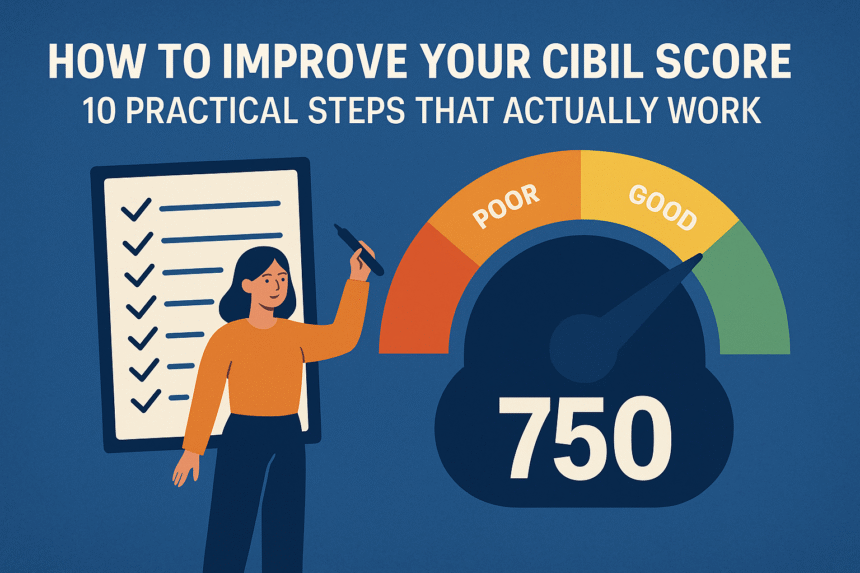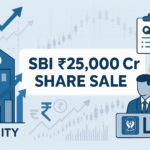Your CIBIL score is more than just a number — it’s your financial reputation. Whether you’re applying for a home loan, a car loan, or even a credit card, your creditworthiness is evaluated based on this three-digit score. A low CIBIL score can result in loan rejections, higher interest rates, and missed financial opportunities.
But here’s the good news: You can improve your CIBIL score with simple, consistent steps.
In this article, we’ll break down 10 practical and proven ways to improve your CIBIL score, along with explanations and examples. No fluff. No complicated terms. Just actionable tips.
💡 What Is a CIBIL Score?
CIBIL (Credit Information Bureau India Limited) is one of the four major credit bureaus in India. It assigns individuals a credit score ranging from 300 to 900. A score above 750 is considered good and increases your chances of getting credit approved easily.
🎯 CIBIL Score Ranges:
- 800–900: Excellent
- 750–799: Very Good
- 700–749: Good
- 650–699: Fair
- 600–649: Poor
- 300–599: Very Poor
🚀 10 Practical Steps to Improve Your CIBIL Score
1️⃣ Pay EMIs and Credit Card Bills on Time – Every Time
This is the golden rule. Your payment history has the maximum weightage in your credit score (around 35%).
✅ Do this:
Set auto-debit for loan EMIs and credit card bills. If you miss even one payment, your score drops.
📌 Example:
Aman had a CIBIL score of 765. One missed EMI and his score dropped to 710. It took him 6 months of on-time payments to regain his previous score.
2️⃣ Keep Credit Card Utilization Below 30%
Credit bureaus don’t just track whether you pay on time, but also how much of your available credit you’re using.
✅ Do this:
If your credit card limit is ₹1,00,000, try to spend less than ₹30,000 per month on it.
⚠️ High utilization = high risk, even if you pay on time.
3️⃣ Avoid Minimum Due Trap on Credit Cards
Paying only the minimum amount due every month keeps your account from being marked “default,” but your outstanding balance keeps building — with interest.
✅ Do this:
Always pay the total due amount or as much above the minimum as possible.
4️⃣ Avoid Too Many Loan or Credit Card Applications
Every time you apply for a credit product, the lender runs a hard inquiry. Too many of these within a short period signals desperation and lowers your score.
✅ Do this:
Compare loan offers using fintech apps or websites — but apply only to 1 or 2 banks.
5️⃣ Diversify Your Credit Mix
Having both secured loans (like home/auto loans) and unsecured loans (like personal loans or credit cards) is good for your credit profile.
✅ Do this:
If you only have credit cards, consider a small personal loan or an overdraft facility (like SBI’s InstaOD).
6️⃣ Monitor Your CIBIL Report Regularly
Sometimes, your CIBIL score might be low due to errors — like incorrect outstanding balances or accounts you never opened.
✅ Do this:
Get one free CIBIL report per year from https://www.cibil.com and check it thoroughly.
If you spot an error, raise a dispute immediately.
7️⃣ Avoid Joint Loan Defaults
If you’ve taken a loan jointly or acted as a guarantor, the other person’s default will affect your score too.
✅ Do this:
Keep track of joint loan payments and avoid standing guarantee for people with poor repayment habits.
8️⃣ Close Unused Credit Cards Wisely
Too many open but unused cards can lower your average account age, and too few may raise utilization.
✅ Do this:
Close the newest or high-fee cards, not the oldest ones.
Why?
A long credit history boosts your score.
9️⃣ Negotiate a Settlement Only as a Last Resort
If you can’t repay a loan, banks may offer a “settlement” — where you pay less than you owe. But that’s a red flag on your credit report.
✅ Do this:
Try to pay in full or restructure the loan. Settlement reflects “Settled” status in your report — damaging your score for years.
🔟 Stay Consistent Over Time
Improving your score is a marathon, not a sprint. Regularly follow good habits — no hacks or shortcuts needed.
✅ Do this:
Treat your credit score like your financial reputation. Build it slowly, and protect it seriously.
📊 Summary Table: Quick Fix vs. Long-Term Habit
| Action | Type | Impact on Score | Timeframe |
|---|---|---|---|
| Paying EMIs on time | Long-term habit | High | 3–6 months |
| Reducing credit card usage | Quick fix | Moderate to High | 1–3 months |
| Not applying for multiple loans | Long-term habit | Medium | Immediate |
| Monitoring credit report | Quick fix | Medium | Immediate |
| Managing joint loans | Long-term habit | High | Ongoing |
💬 Real-World Impact: A Short Story
Sunita, a self-employed designer, had a CIBIL score of 605 due to late payments and high card usage.
She followed 7 of these 10 steps — and within 11 months, her score jumped to 783.
She was able to get a car loan at 9.25% instead of 12.5% — saving over ₹45,000 in interest.
🎯 Final Thoughts
A strong CIBIL score isn’t just a ticket to easier loans — it’s proof that you’re financially disciplined.
“A good credit score won’t make you rich. But a bad one can definitely keep you poor.”
Start small. Be consistent. The results will follow.
📌 Quick Action Steps
- ✅ Download your free CIBIL report today.
- ✅ Set reminders for EMI and bill due dates.
- ✅ Reduce credit usage this month.
- ✅ Don’t apply for new credit unless necessary.
- ✅ Bookmark this guide and review it monthly.






